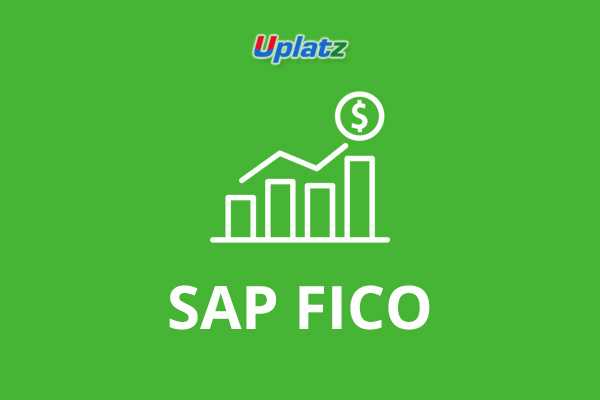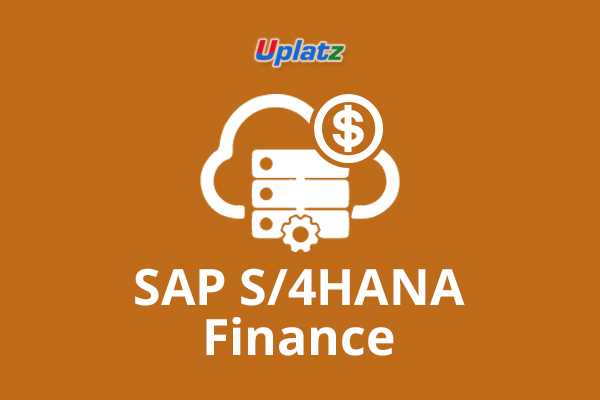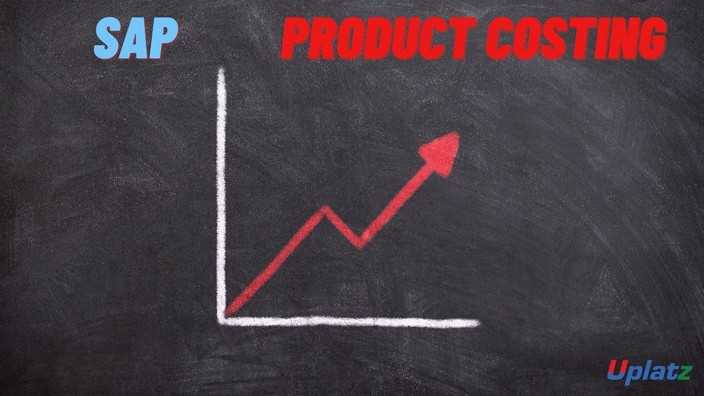Asset Accounting in SAP
SAP Asset Accounting serves as a subsidiary ledger to the general ledger. It provides financial reporting system to a central transformation platformPreview Asset Accounting in SAP course
View Course Curriculum Price Match Guarantee Full Lifetime Access Access on any Device Technical Support Secure Checkout Course Completion Certificate 78% Started a new career
BUY THIS COURSE (GBP 29)
78% Started a new career
BUY THIS COURSE (GBP 29)
-
 89% Got a pay increase and promotion
89% Got a pay increase and promotion
Students also bought -
-

- SAP FICO (basic to advanced)
- 30 Hours
- GBP 29
- 347 Learners
-

- SAP S/4HANA Finance
- 20 Hours
- GBP 29
- 566 Learners
-

- SAP Product Costing
- 5 Hours
- GBP 29
- 86 Learners

Asset Accounting is a subsidiary ledger of the general ledger and is used to manage and document fixed asset transactions in detail. In general ledger accounting, you update depreciation and changes to asset balance sheet values in asset accounting. You make various account assignments to cost accounting for these transactions. Because of the integration in SAP S/4HANA, SAP Asset Accounting (FI-AA) transfers data directly to and from other SAP S/4HANA components such as Financial Accounting (FI) components.
SAP Asset Accounting (FI-AA) is a submodule of SAP's Financial Accounting (FI) module that manages and supervises fixed assets within an organization. It provides tools for detailed tracking and reporting of an organization's asset-related activities and integrates with other SAP modules such as General Ledger (FI-GL), Controlling (CO), Plant Maintenance (PM), and Materials Management (MM).
In the SAP system, it is the Asset Accounting (FI-AA) component that is responsible for managing fixed asset processes such as acquisitions, transfers, retirements, depreciation, revaluations, and reporting. SAP Asset Accounting is tightly integrated with many other modules like MM, PM etc. For example, if an item is purchased that can be considered as an asset, the information will pass to the Asset Accounting module (FI-AA) from MM module.
Key Features of SAP Asset Accounting:
1) Asset Master Data Management
a. Creation and Maintenance: Allows the creation and maintenance of asset master records, including asset numbers, descriptions, categories, locations, and other attributes.
b. Asset Classes: Categorizes assets into different classes to manage them more effectively (e.g., buildings, machinery, vehicles).
2) Asset Transactions
a. Acquisitions: Records asset acquisitions either through purchases, in-house production, or external donations.
b. Retirements: Manages asset retirements, whether through sales, scrapping, or transfers.
c. Transfers: Facilitates internal transfers of assets between different company codes, cost centers, or locations.
d. Depreciation: Automates calculation and posting of depreciation based on predefined methods and asset useful life.
3) Depreciation Management
a. Depreciation Areas: Defines multiple depreciation areas for different accounting and reporting requirements (e.g., local GAAP, IFRS, tax purposes).
b. Depreciation Methods: Supports various depreciation methods (straight-line, declining balance, units of production, etc.).
4) Integration with Other Modules
a. General Ledger: Ensures all asset-related transactions are reflected in the general ledger for accurate financial reporting.
b. Controlling: Aligns asset costs with cost centers, internal orders, and projects.
c. Plant Maintenance: Links assets with maintenance activities for better asset lifecycle management.
d. Materials Management: Synchronizes asset acquisition with procurement processes.
5) Reporting and Analysis
a. Standard Reports: Provides standard reports for asset balances, acquisitions, retirements, depreciation, and historical cost.
b. Custom Reports: Enables customization of reports to meet specific business requirements.
c. Asset History Sheets: Generates detailed history sheets showing all changes and transactions related to an asset.
6) Asset Revaluation
a. Revaluation: Adjusts asset values to reflect fair market value, ensuring compliance with accounting standards.
b. Impairment: Records and reports asset impairments as required by accounting principles.
7) Asset Accounting Configuration
a. Chart of Depreciation: Defines the structure of depreciation areas and methods.
b. Account Determination: Configures account determination rules for various asset transactions.
c. Integration Settings: Establishes integration settings with other modules for seamless data flow.
Uplatz offers this in-depth training on SAP Asset Accounting to help you move to a flourishing career in SAP Finance and Accounting. Learn the essentials of posting acquisitions, retirements and transfers in the Asset Accounting module (FIAA) in SAP.
Course/Topic - Asset Accounting in SAP - all lectures
-
In this video tutorial, you will be getting an overview on what is Asset Accounting, a picturesque diagram on the life cycle of fixed assets and why Asset Accounting is considered as sub ledger in SAP system.
-
In this video, you will be learning an overview of adding new entries in Asset Accounting with the help of a live example. Further, you will learn how to create assets in GL accounts and assignment of accounts for automatic postings.
-
In this lecture, you will understand the Depreciation process in Asset Accounting, along with defining multi-level methods in terms of Depreciation and linking the assets with the Depreciation key under the Asset Master. Further, it will be proceeded on a walk around with the Asset Explorer.
-
In this video tutorial, you will be able to understand on how to work on the Asset Retirement with customer which will be presented with a live example. You will also learn what are the conditions involved in doing an Asset Sale without a customer and what are the steps involved in the process.
-
This session of the course deals with Asset Impairment which is nothing but damaging of assets, how it is related to unplanned depreciation and what is the process involved in working on the unplanned depreciation.
1).Understand how to process depreciation and year-end closing
2).Learn how to work with assets, transactions and depreciation
3).Post common transactions such as acquisitions, retirements, transfers
4).Run important asset reports such as Asset Balances, Total Depreciation and Asset History Sheet
5).The Asset Accounting (FI-AA) component is used for managing and supervising fixed assets with the SAP System.
6).In Financial Accounting, it serves as a subsidiary ledger to the General Ledger, providing detailed information on transactions involving fixed assets.
1).Copy reference chart of depreciation
2).Assignment of chart of depreciation to company code
3).Creation of 0% tax codes for sales and purchases
4).Defining account determination
5).Definition of screen lay out rules
6).Definition of number ranges for asset master
7).Creation of asset classes
8).Integration with General Ledger & Posting rules
9).Defining Depreciation key
10).Definition of multilevel methods
11).Definition of period control methods
12).Creation of main asset master records
13).Creation of sub asset master records
14).Posting the transactions for Acquisition of fixed assets
15).Depreciation run and Asset explorer
16).Sale of fixed assets – with customer and without customer
17).Transfer of assets
18).Impairment of assets
19).Scrapping of assets
20).Line item Settlement of assets under construction of capital work in progress
SAP FI-AA components
The important components SAP Asset Accounting are:
1).Basic Functions:
2).Master data (asset maintenance)
3).Basic valuation functions
4).Depreciation
5).Transactions, such as asset acquisitions and retirements
6).Closing operations
7).And more
8).Special Valuations: For example, for investment support and insurance
9).Processing leased assets
10).Preparations for consolidation for group financial statements
11).Information System
Important Configurations of SAP FI-AA
The important configurations in SAP Asset Accounting are:
1).How to define charts of depreciation
2).Define tax code on sales and purchases
3).How to Assign chart of depreciation to company code
4).How to specify account determination
5).How to create screen layout rules
6).How to Maintain asset number range intervals
7).How to define asset classes
8).How to Determine depreciation areas in asset classes
9).How to Specify intervals and posting rules
10).How to define screen layout for asset master data
11).Procedure to maintain screen layout for depreciation areas
12).how to create base methods
13).How to create declining balance method
14).How to create multilevel method
15).How to create depreciation key in SAP
16).Create asset master data in SAP
17). Create sub asset master data in SAP
This Asset Accounting in SAP training course is designed for clearing the SAP Certified Fixed Asset Accountant exam.
In Asset Accounting in SAP Course module the participants can learn to manage the key activities such as managing and documenting fixed asset transactions. In the Asset Accounting in SAP course, the participants will learn the asset accounting key steps such as asset master creation, asset valuation and create legacy assets. This seems to be an essential learning for all SAP Finance Accounts module users.
Asset Accounting in SAP Certification is an important benchmark in becoming an expert Fixed Asset Accountant as the course covers asset accounting components such as master data, leased asset process, and information system. Asset Accounting in SAP tutorial helps the participants to learn all the key concepts of asset accounting thus attaining a unique SAP certification. Asset Accounting in SAP course offers complete information about accounts Receivable sub-module of SAP FICO thus making the participant an expert Fixed Asset Accountant.
Uplatz online training guarantees the participants to successfully go through the Asset Accounting certification provided by SAP. Uplatz provides appropriate teaching and expertise training to equip the participants for implementing the learnt concepts in an organization. Uplatz Course Completion Certificate will be awarded upon the completion of the Asset Accounting in SAP course training.
The Asset Accounting in SAP certification exam verifies that the participants possess basic knowledge and can prove their skills in the area of SAP ERP Financial Accounting. This Asset Accounting in SAP certification exam validates that the participant has an overall understanding about this Fixed Asset Accountant profile, and able to implement the knowledge practically in projects.
Below given are the Certification details of:
a).SAP Certified Application Associate - Financial Accounting with SAP ERP 6.0 EhP7
b).Certification Level: Associate
c).Exam Name: SAP Certified Application Associate - Financial Accounting with SAP ERP 6.0 EhP7
d).Exam Code: C_TFIN52_67
e).Exam Mode: Online
f).Total Number of Questions: 80
g).Pass Score: 60%
h).Time Duration: 180 Minutes
The SAP Fixed Asset Accountant draws an average salary of $83,748 per year depending on the knowledge and hands-on experience. The SAP Fixed Asset Accountant job roles are in high demand and make a rewarding career.
SAP Fixed Asset Accountants are recognized across the globe. The increased usage of the finance processes in many companies help the participants to find a job opportunity easily. The leading companies hire SAP Fixed Asset Accountant considering the skill of managing daily accounting of property. The Learners earn most beneficial Asset Accounting in SAP certification through our expert training and course curriculum. Being SAP Fixed Asset Accountant certified is definitely valuable credential and adds value to every organization.
The Asset Accounting in SAP certification is targeted to those participants who are beginners or from finance accounting background and excel as SAP Fixed Asset Accountant.
The following are the job titles:
1).Accountant
2).Staff Accountant
3).Asset Manager
4).SAP Accounts Consultant
5).Accounts Consultant
The course content, and the overall certification program helps the participants to get placed in reputed MNCs and organizations.
Q1. What is Chart of Depreciation?
Ans-The Chart of Depreciation is a list of Depreciation Areas arranges according to business and legal requirement.Chart of Depreciation is used in order to manage various legal requirements for the depreciation and valuation of assets. Each company code is allocated to one chart of depreciation.
Q2. What do you mean by Depreciation Area?
Ans-Methods of calculation of depreciation. An area showing a valuation of fixed assets for a particular purpose. For example Book depreciation, Income Tax Depreciation, Costing depreciation.
Q3. What is Account Determination?
Ans-One of the most important functions of the Asset class to be establish the connection between the Asset master record and the corresponding accounts in the general ledger in Financial accounting. This connection is created by the account determination key is asset class.
Q4. What is Screen Layout?
Ans-Design of the records and design of the documents.
Q5.What is Asset Class?
Ans-The Asset class is the main criteria for classifying assets. Every asset must be assigned to any one class. The asset class is nothing but a group of asset. For example of Asset classes are Plant & Machinery, Furniture & Fixtures, Computer etc.
Q6. What is Depreciation Key?
Ans-A key for calculating depreciation amounts. There is a direct link between asset and company code. Which we link between the depreciation key and master record.
Q7. What is an asset master? What does it control for sub asset master?
Ans-An asset master represents the master record and information about a particular asset. According to the screen layout of asset master, it controls the following sub assets
a).Sub assets master number assignment
b).Assignment of depreciation key
c).Determination of life asset
d).determination of assignment of group asset
Q8.How many depreciation areas can be defined for a Company Code?
Ans-Depreciation areas are not defined for company codes rather depreciation areas are defined for a chart of depreciation, A maximum f 99 depreciation areas cab be maintained for a Chart of Depreciation.
Q9. What are the types of Depreciation methods?
Ans-
a).Base method
b).Decline value method
c).Maximum method
d).Multi level method
e).Period control method
Q10. Is it possible to create an asset class automatically?
Ans-Yes, there are two ways:
1).Create an asset class with reference to an existing asset class
2).Generate an asset class through the asset class transaction code(ANKL)
Q11. How many ways can you create the asset master record?
Ans-
a).With reference to an asset
b).Using the number functionality for similar assets
c).Through an asset class (AS01)
Q12.What is the difference between COA and COD?
Ans-The chart of Accounts is the index of G/L accounts. The Chart of Account can be global, country specific or industry specific based on the need of business. The COD is the index of depreciation areas. The COD is only country specific.
Q13.What are the segments in asset master?
Ans-Master data segment and Depreciation segment









